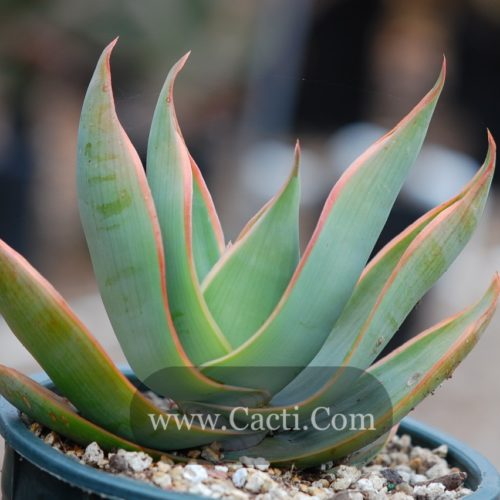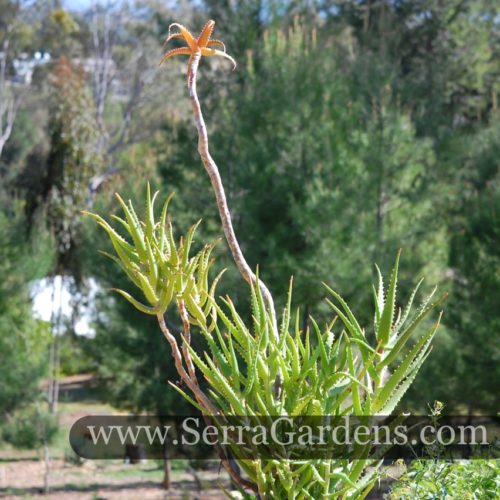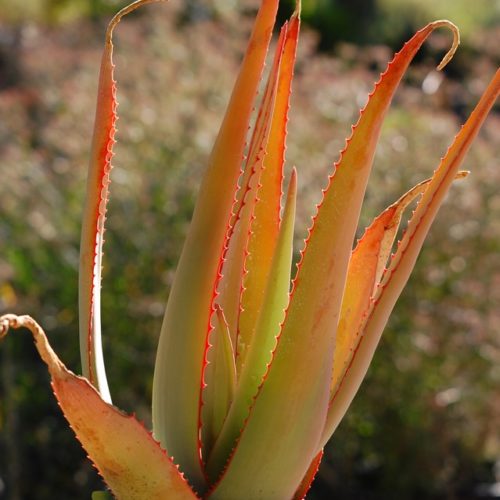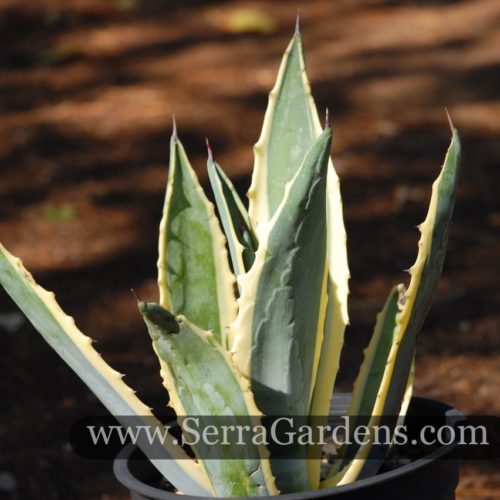Aeonium canariense virgineum
Horticultural Data | Shipping & Availability | Top
Aeonium canariense virgineum is a medium-sized aeonium prized for its soft velvety appearance, and profuse mounds of bright green rosettes covered in small hairs. In bright sun, these rosettes can form a red edge adding to its dramatic appearance.
In spring, Aeonium canariense virgineum is a well-known butterfly attracting plant. It sends up a flower spike of yellow blooms which can last for several weeks. Aeonium canariense virgineum is usually monocarpic and the blooming stem dies leaving behind seeds and many pups. This plant tends to spread laterally, resembling a colony of large sempervivum aka ‘Hens and Chicks’. In its native Canary Island habitat, this succulent grows on lava rock so it is a very hardy plant, however needs excellent drainage to thrive.
Aeonium canariense virgineum can be used to create visual interest in containers, roof decks, lawn edges, borders, and even rock gardens. It is also an attractive contrast to cactus and dry grasses. Plants remain short and close to the ground and do not form long branch like many aeoniums. Leaves are covered with small hairs giving it an inviting fuzzy appearance. Aeoniums like to grow during winter months when moisture is more available. Many aeoniums go dormant during summer. Heads cup up and tighten.
Horticultural Data
Description | Horticultural Data | Shipping & Availability | Top
Names and Synonyms: Aeonium canariense viriginum, Sempervivum canariense
Common Names: Giant Velvet Rose, Mint Saucer, Hen and Chicks Aeonium
Family: Crassulaceae
Origin: Canary Islands
Size Label: 1 Gallon
Height: 1-2′
Width: 1-2′
Cold Tolerance: 25 to 30°F; -3.9 to -1.1°C
Heat Tolerance: High heat tolerance.
Light Requirement: Light shade to half day full sun
Water needs: Drought tolerant but looks better with some irrigation.
Maintenance: Remove spent flower spikes. Remove and replant offsets as desired.
Uses: Aeonium canariense virgineum can be used to create visual interest in containers, roof decks, lawn edges, borders, and even rock gardens. It is also an attractive contrast to cactus and dry grasses. Plants remain short and close to the ground and do not form long branch like many aeoniums. Leaves are covered with small hairs giving it a inviting fuzzy appearance. Aeoniums like to grow during winter months when moisture is more available. Many aeoniums go dormant during summer. Heads cup up and tighten.
Propagation: Remove offsets and replant them. Seeds.
Problems: Root rot in poor draining soils. Snails like to eat young leaves.
Research Links:
http://davesgarden.com/guides/pf/go/63881/
http://www.rchstudios.com/aeonium-canariense/
http://www.gardenersworld.com/plants/aeonium-canariense/3084.html
http://www.desert-tropicals.com/Plants/Crassulaceae/Aeonium_canariense.html
Shipping & Availability
Description | Horticultural Data | Shipping & Availability | Top
There is a minimum purchase of any 4 plants for online orders. All plants shipped bare root. Other sizes may be available for pick up from our growing grounds in Fallbrook, CA. For more information, give us a call at 760-990-4762.
Click here for complete Price List.




